Tailoring of Hydrogen Generation by Hydrolysis of Magnesium Hydride in Organic Acids Solutions and Development of Generator of the Pressurised H2 Based on this Process
Abstract
1. Introduction
2. Results and Discussion
2.1. Characterisation of Starting Material and Solid Residues after Its Hydrolysis
2.2. Hydrolysis of Commercial MgH2
- In all studied cases, the fitted values of incubation period, ti = 0.4–0.5 min, change insignificantly and appear to be related to the specifics of the applied experimental procedure;
- The fitted Avrami exponents vary within the range n = 0.5–1.1, close to the values reported by Huang et al. [39] for the hydrolysis of MgH2 in 0.5–4.5 wt.% aqueous solutions of NH4Cl. According to ref. [52], the values of n close to 0.5 correspond to diffusion as the rate-limiting step while the higher values of n testify about possible contribution of the nucleation and growth mechanism;
- The hydrolysis activation energies calculated from the temperature dependencies of the fitted values of rate constants, K = 1/t0, vary between 20 and 37 kJ/mol. We note that the presented values are just rough estimations due to rather poor fitting of the data with Equation (5) (see Figure S1 in Supplementary Information). In our opinion, this is caused by the under-estimation of the measured hydrogen evolution rates above 1.5 Nl/(min g) that takes place at the higher temperature (75 °C) and/or the higher concentrations of the organic acids.
2.3. Application-Related Findings
- The possibility of effectively controlling the process by controlling the acid/MgH2 ratio in the reaction solution, as well as its temperature;
- The availability and low cost of magnesium and citric acid;
- The high solubility of both citric acid and magnesium citrate in water;
- The formation of moderately acidic buffer solutions “citric acid—magnesium citrate” characterised by pH between 3 and 5 in a wide range of concentrations. The range of the pH is sufficient to suppress the deposition of Mg(OH)2 passivation layer on the surface of the MgH2 particles and, thus, to provide a high yield of hydrogen generation. At the same time, it creates less corrosive medium than in the case of mineral acids, or oxalic acid studied in this work;
- As distinct from acetic acid, citric acid is not volatile which significantly reduces the contamination of the released H2 containing only easily removed impurities of water vapours and mist of the reaction solution;
- The lower rates in combination with lower activation energy of H2 generation by hydrolysis of MgH2 in the solution of citric acid allow more efficient process control due to less pronounced self-heating of the reaction solution when highly exothermic hydrolysis reaction takes place.
3. Generation of Compressed Hydrogen by Hydrolysis of Mg or MgH2 in Citric Acid Solution
4. Materials and Methods
4.1. Materials and Their Characterisation
4.2. Hydrolysis Experiments and Data Processing
5. Conclusions
6. Patents
- Compressed Hydrogen Producing Method and Device for Implementation Thereof, by A.A. Arbuzov, Y.Y. Shimkus, S.A. Mozhzhukhin, V.B. Son, and B.P. Tarasov. RU 2735285 C1 (2020).
Supplementary Materials
Author Contributions
Funding
Data Availability Statement
Acknowledgments
Conflicts of Interest
References
- Dell, R.M.; Rand, D.A.G. Energy Storage—A Key Technology for Global Energy Sustainability. J. Power Sources 2001, 100, 2–17. [Google Scholar] [CrossRef]
- Barbir, F. PEM Fuel Cells: Theory and Practice, 2nd ed.; Academic Press/Elsevier: Amsterdam, The Netherlands, 2013. [Google Scholar]
- Faye, O.; Szpunar, J.; Eduok, U. A Critical Review on the Current Technologies for the Generation, Storage, and Transportation of Hydrogen. Int. J. Hydrogen Energy 2022, 47, 13771–13802. [Google Scholar] [CrossRef]
- Chakraborty, S.; Dash, S.K.; Elavarasan, R.M.; Kaur, A.; Elangovan, D.; Meraj, S.T.; Kasinathan, P.; Said, Z. Hydrogen Energy as Future of Sustainable Mobility. Front. Energy Res. 2022, 10, 893475. [Google Scholar] [CrossRef]
- Hassan, I.A.; Ramadan, H.S.; Saleh, M.A.; Hissel, D. Hydrogen Storage Technologies for Stationary and Mobile Applications: Review, Analysis and Perspectives. Renew. Sustain. Energy Rev. 2021, 149, 111311. [Google Scholar] [CrossRef]
- Gil-San-Millan, R.; Grau-Atienza, A.; Johnson, D.T.; Rico-Francés, S.; Serrano, E.; Linares, N.; García-Martínez, J. Improving Hydrogen Production from the Hydrolysis of Ammonia Borane by Using Multifunctional Catalysts. Int. J. Hydrogen Energy 2018, 43, 17100–17111. [Google Scholar] [CrossRef]
- Akbayrak, S.; Çakmak, G.; Öztürk, T.; Özkar, S. Rhodium(0), Ruthenium(0) and Palladium(0) Nanoparticles Supported on Carbon-Coated Iron: Magnetically Isolable and Reusable Catalysts for Hydrolytic Dehydrogenation of Ammonia Borane. Int. J. Hydrogen Energy 2021, 46, 13548–13560. [Google Scholar] [CrossRef]
- Abdelhamid, H.N. A Review on Hydrogen Generation from the Hydrolysis of Sodium Borohydride. Int. J. Hydrogen Energy 2021, 46, 726–765. [Google Scholar] [CrossRef]
- Tarasov, B.P. Metal-Hydride Accumulators and Generators of Hydrogen for Feeding Fuel Cells. Int. J. Hydrogen Energy 2011, 36, 1196–1199. [Google Scholar] [CrossRef]
- Zhu, Y.; Li, J.; Yang, L.; Huang, Z.; Yang, X.-S.; Zhou, Q.; Tang, R.; Shen, S.; Ouyang, L. Closed Loops for Hydrogen Storage: Hydrolysis and Regeneration of Metal Borohydrides. J. Power Sources 2023, 563, 232833. [Google Scholar] [CrossRef]
- Yartys, V.; Zavaliy, I.; Berezovets, V.; Pirskyy, Y.; Manilevich, F.; Kytsya, A.; Verbovytskyy, Y.; Dubov, Y.; Kutsyi, A. Hydrogen Generator Integrated with Fuel Cell for Portable Energy Supply. J. Phys. Energy 2023, 5, 014014. [Google Scholar] [CrossRef]
- Liu, H.; Yang, F.; Yang, B.; Zhang, Q.; Chai, Y.; Wang, N. Rapid Hydrogen Generation through Aluminum-Water Reaction in Alkali Solution. Catal. Today 2018, 318, 52–58. [Google Scholar] [CrossRef]
- Xu, H.; Wang, H.; Zhang, Z.; Tu, H.; Xiong, J.; Xiang, X.; Wei, C.; Mishra, Y.K. High Efficiency Al-Based Multicomponent Composites for Low-Temperature Hydrogen Production and Its Hydrolysis Mechanism. Int. J. Hydrogen Energy 2023, 48, 26260–26275. [Google Scholar] [CrossRef]
- Legrée, M.; Bobet, J.-L.; Mauvy, F.; Sabatier, J. Modeling Hydrolysis Kinetics of Dual Phase α-Mg/LPSO Alloys. Int. J. Hydrogen Energy 2022, 47, 23084–23093. [Google Scholar] [CrossRef]
- Liu, Z.; Zhong, J.; Leng, H.; Xia, G.; Yu, X. Hydrolysis of Mg-Based Alloys and Their Hydrides for Efficient Hydrogen Generation. Int. J. Hydrogen Energy 2021, 46, 18988–19000. [Google Scholar] [CrossRef]
- al Bacha, S.; Pighin, S.A.; Urretavizcaya, G.; Zakhour, M.; Castro, F.J.; Nakhl, M.; Bobet, J.L. Hydrogen Generation from Ball Milled Mg Alloy Waste by Hydrolysis Reaction. J. Power Sources 2020, 479, 228711. [Google Scholar] [CrossRef]
- Kushch, S.D.; Kuyunko, N.S.; Nazarov, R.S.; Tarasov, B.P. Hydrogen-Generating Compositions Based on Magnesium. Int. J. Hydrogen Energy 2011, 36, 1321–1325. [Google Scholar] [CrossRef]
- Sevastyanova, L.G.; Genchel, V.K.; Klyamkin, S.N.; Larionova, P.A.; Bulychev, B.M. Hydrogen Generation by Oxidation of “Mechanical Alloys” of Magnesium with Iron and Copper in Aqueous Salt Solutions. Int. J. Hydrogen Energy 2017, 42, 16961–16967. [Google Scholar] [CrossRef]
- Kojima, Y.; Suzuki, K.-I.; Kawai, Y. Hydrogen Generation by Hydrolysis Reaction of Magnesium Hydride. J. Mater. Sci. 2004, 39, 2227–2229. [Google Scholar] [CrossRef]
- Tegel, M.; Schöne, S.; Kieback, B.; Röntzsch, L. An Efficient Hydrolysis of MgH2-Based Materials. Int. J. Hydrogen Energy 2017, 42, 2167–2176. [Google Scholar] [CrossRef]
- Verbovytskyy, Y.V.; Berezovets, V.V.; Kytsya, A.R.; Zavaliy, I.Y.; Yartys, V.A. Hydrogen Generation by the Hydrolysis of MgH2. Mater. Sci. 2020, 56, 1–14. [Google Scholar] [CrossRef]
- Zhu, Y.; Wang, Y.; Zeng, L.; Wu, D.; Lu, C.; Yang, X.-S.; Zhou, Q.; Tang, R.; Xiao, F. Effect of Metaborate Additive Modification on Hydrolysis Performance of MgH 2. ACS Appl. Energy Mater. 2023, 6, 461–470. [Google Scholar] [CrossRef]
- Berezovets, V.V.; Kytsya, A.R.; Zasadnyy, T.M.; Zavaliy, I.Y.; Yartys, V.A. Generation of Hydrogen by the Hydrolysis of Mixtures of Magnesium Hydride with Citric Acid. Mater. Sci. 2022, 58, 350–356. [Google Scholar] [CrossRef]
- Ouyang, L.; Liu, M.; Chen, K.; Liu, J.; Wang, H.; Zhu, M.; Yartys, V. Recent Progress on Hydrogen Generation from the Hydrolysis of Light Metals and Hydrides. J. Alloys Compd. 2022, 910, 164831. [Google Scholar] [CrossRef]
- Hiraki, T.; Okinaka, N.; Uesugi, H.; Akiyama, T. Direct Production of Pressurized Hydrogen from Waste Aluminum without Gas Compressor. In Materials Issues in a Hydrogen Economy; World Scientific: Singapore, 2009; pp. 54–61. [Google Scholar]
- Yartys, V.A.; Lototskyy, M.V.; Akiba, E.; Albert, R.; Antonov, V.E.; Ares, J.R.; Baricco, M.; Bourgeois, N.; Buckley, C.E.; Bellosta von Colbe, J.M.; et al. Magnesium Based Materials for Hydrogen Based Energy Storage: Past, Present and Future. Int. J. Hydrogen Energy 2019, 44, 7809–7859. [Google Scholar] [CrossRef]
- Grosjean, M.H.; Zidoune, M.; Roué, L.; Huot, J.Y. Hydrogen Production via Hydrolysis Reaction from Ball-Milled Mg-Based Materials. Int. J. Hydrogen Energy 2006, 31, 109–119. [Google Scholar] [CrossRef]
- Ouyang, L.; Ma, M.; Huang, M.; Duan, R.; Wang, H.; Sun, L.; Zhu, M. Enhanced Hydrogen Generation Properties of MgH2-Based Hydrides by Breaking the Magnesium Hydroxide Passivation Layer. Energies 2015, 8, 4237–4252. [Google Scholar] [CrossRef]
- Pighin, S.A.; Urretavizcaya, G.; Bobet, J.L.; Castro, F.J. Nanostructured Mg for Hydrogen Production by Hydrolysis Obtained by MgH2 Milling and Dehydriding. J. Alloys Compd. 2020, 827, 154000. [Google Scholar] [CrossRef]
- Zhao, Y.; Li, T.; Huang, H.; Xu, T.; Liu, B.; Zhang, B.; Yuan, J.; Wu, Y. A Highly Efficient Hydrolysis of MgH2 Catalyzed by NiCo@C Bimetallic Synergistic Effect. J. Mater. Sci. Technol. 2023, 137, 176–183. [Google Scholar] [CrossRef]
- Hiroi, S.; Hosokai, S.; Akiyama, T. Ultrasonic Irradiation on Hydrolysis of Magnesium Hydride to Enhance Hydrogen Generation. Int. J. Hydrogen Energy 2011, 36, 1442–1447. [Google Scholar] [CrossRef]
- Grosjean, M.H.; Zidoune, M.; Huot, J.Y.; Roué, L. Hydrogen Generation via Alcoholysis Reaction Using Ball-Milled Mg-Based Materials. Int. J. Hydrogen Energy 2006, 31, 1159–1163. [Google Scholar] [CrossRef]
- Zhao, Z.; Zhu, Y.; Li, L. Efficient Catalysis by MgCl2 in Hydrogen Generation via Hydrolysis of Mg-Based Hydride Prepared by Hydriding Combustion Synthesis. Chem. Commun. 2012, 48, 5509. [Google Scholar] [CrossRef]
- Gan, D.; Liu, Y.; Zhang, J.; Zhang, Y.; Cao, C.; Zhu, Y.; Li, L. Kinetic Performance of Hydrogen Generation Enhanced by AlCl3 via Hydrolysis of MgH2 Prepared by Hydriding Combustion Synthesis. Int. J. Hydrogen Energy 2018, 43, 10232–10239. [Google Scholar] [CrossRef]
- Berezovets, V.; Kytsya, A.; Zavaliy, I.; Yartys, V.A. Kinetics and Mechanism of MgH2 Hydrolysis in MgCl2 Solutions. Int. J. Hydrogen Energy 2021, 46, 40278–40293. [Google Scholar] [CrossRef]
- Sevastyanova, L.G.; Klyamkin, S.N.; Stupnikov, V.A.; Bulychev, B.M. Disposable Hydrogen Generators: Magnesium Hydride Oxidation in Aqueous Salts Solutions. Int. J. Hydrogen Energy 2022, 47, 92–101. [Google Scholar] [CrossRef]
- Makhaev, V.D.; Petrova, L.A.; Tarasov, B.P. Hydrolysis of Magnesium Hydride in the Presence of Ammonium Salts. Russian J. Inorg. Chem. 2008, 53, 858–860. [Google Scholar] [CrossRef]
- Hiraki, T.; Hiroi, S.; Akashi, T.; Okinaka, N.; Akiyama, T. Chemical Equilibrium Analysis for Hydrolysis of Magnesium Hydride to Generate Hydrogen. Int. J. Hydrogen Energy 2012, 37, 12114–12119. [Google Scholar] [CrossRef]
- Huang, M.; Ouyang, L.; Wang, H.; Liu, J.; Zhu, M. Hydrogen Generation by Hydrolysis of MgH2 and Enhanced Kinetics Performance of Ammonium Chloride Introducing. Int. J. Hydrogen Energy 2015, 40, 6145–6150. [Google Scholar] [CrossRef]
- Tegel, M.; Rontzsch, L.; Kieback, B. Composite Material for Hydrolytically Generating Hydrogen, Device for Hydrolytically Generating Hydrogen, Method for Generating Hydrogen, Device for Generating Electric Energy, and Possible Applications. U.S. Patent 10239753 B2, 26 March 2019. [Google Scholar]
- Ryu, W.; Braithwaite, D.; Fabian, T. Chemical Hydride Formulation and System Design for Controlled Generation of Hydrogen. U.S. Patent Application 2011/0020215 A1, 27 January 2011. [Google Scholar]
- Mauvy, F.C.M.; Bobet, J.-L.; Sabatier, J.; Bos, F. Use of a Magnesium-Based Material for Producing Dihydrogen or Electricity. U.S. Patent 10407303 B2, 10 September 2019. [Google Scholar]
- Wankewycz, T.; Crawford, M.M.; Tan, L.Y.; Zhang, X. High Energy Density Fuel Cell Apparatus and System with a Hydride-Based Hydrogen Generator as a Scalable Power Solution Concept. U.S. Patent Application 2022/0131214 A1, 28 April 2022. [Google Scholar]
- Arbuzov, A.A.; Shimkus, Y.Y.; Mozhzhukhin, S.A.; Son, V.B.; Tarasov, B.P. Compressed Hydrogen Producing Method and Device for Implementation Thereof. Russian Patent 2735285 C1, 29 October 2020. [Google Scholar]
- Sgroi, A., Jr.; Stepan, C.R.; Curello, A.J.; Curello, M. Fuels for Hydrogen Generating Cartridges. U.S. Patent 8636961 B2, 28 January 2014. [Google Scholar]
- Li, H.; Fu, Q.; Qin, H.; Chen, X.; Zhang, Q.; Zhang, H.; Wang, S.; Dong, Z.; Wang, M. Geometric Optimization of Hydrolysis Reactors to Enhance MgH2 Hydrolysis Performance. Energy Fuels 2023, 37, 693–701. [Google Scholar] [CrossRef]
- Davids, M.W.; Sekgobela, T.K.; Lototskyy, M.V.; Mozhzhukhin, S.A.; Arbuzov, A.A.; Tarasov, B.P. The Effect of Organic Acids and Graphene-Like Material on the Hydrolysis of Magnesium Hydride. In Proceedings of the HYPOTHESIS XV International Symposium: HYdrogen POwer THeoretical & Engineering Solutions, Online, 8 November 2021; Monteleone, G., Spazzafumo, G., Eds.; pp. 98–100. [Google Scholar]
- Lototskyy, M.; Davids, M.W.; Sekgobela, T.K.; Arbuzov, A.; Mozhzhukhin, S.; Zhu, Y.; Tang, R.; Tarasov, B. Hydrogen Generation by Hydrolysis of Magnesium Hydride in Organic Acids Solutions. Preprint 2023. [Google Scholar] [CrossRef]
- Peisach, J.; Brescia, F. The Mechanism of the Precipitation of Magnesium Oxalate from Supersaturated Solutions. J. Am. Chem. Soc. 1954, 76, 5946–5948. [Google Scholar] [CrossRef]
- Chemistry LibreTexts. Available online: https://chem.libretexts.org/Ancillary_Materials/Reference/Reference_Tables/Equilibrium_Constants/E1%3A_Acid_Dissociation_Constants_at_25C (accessed on 19 July 2022).
- Berger, L.I.; Covington, A.K.; Fischer, K.; Fontaine, J.-C.; Frederikse, H.P.R.; Fuhr, J.R.; Gmehling, J.; Goldberg, R.N.; Hammond, C.R.; Holden, N.E.; et al. CRC Handbook of Chemistry and Physics, Internet Version; Lide, D.L., Ed.; CRC Press: Boca Raton, FL, USA, 2005. [Google Scholar]
- Førde, T.; Maehlen, J.P.; Yartys, V.A.; Lototsky, M.V.; Uchida, H. Influence of Intrinsic Hydrogenation/Dehydrogenation Kinetics on the Dynamic Behaviour of Metal Hydrides: A Semi-Empirical Model and Its Verification. Int. J. Hydrogen Energy 2007, 32, 1041–1049. [Google Scholar] [CrossRef]
- Moriwaki, T.; Akahama, Y.; Kawamura, H.; Nakano, S.; Takemura, K. Structural Phase Transition of Rutile-Type MgH 2 at High Pressures. J. Phys. Soc. Japan 2006, 75, 074603. [Google Scholar] [CrossRef]
- Zavaliy, I.; Denys, R.V.; Berezovets, V.; Boncour, P.V. Phase Relationships in the Mg-Ti-Ni System at 450 °C. In Proceedings of the Abstr. 10th Int. Conf. Cryst. Chem. Intermet. Compd./ASM Alloy Phase Diagrams Cent., Lvov, Ukraine, 2007; p. 58. [Google Scholar]
- Chizmeshya, A.V.G.; McKelvy, M.J.; Sharma, R.; Carpenter, R.W.; Bearat, H. Density Functional Theory Study of the Decomposition of Mg(OH)2: A Lamellar Dehydroxylation Model. Mater. Chem. Phys. 2003, 77, 416–425. [Google Scholar] [CrossRef]

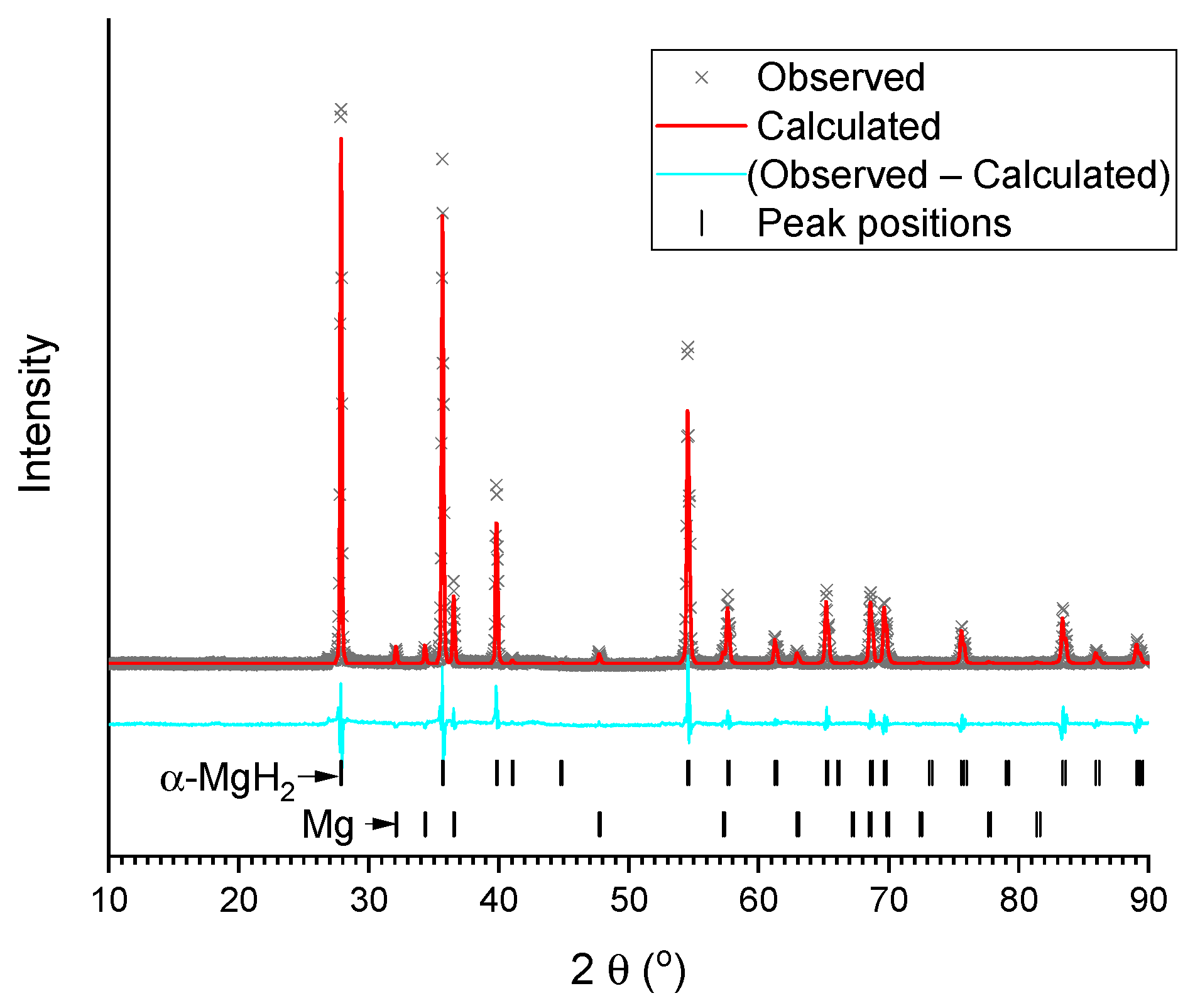
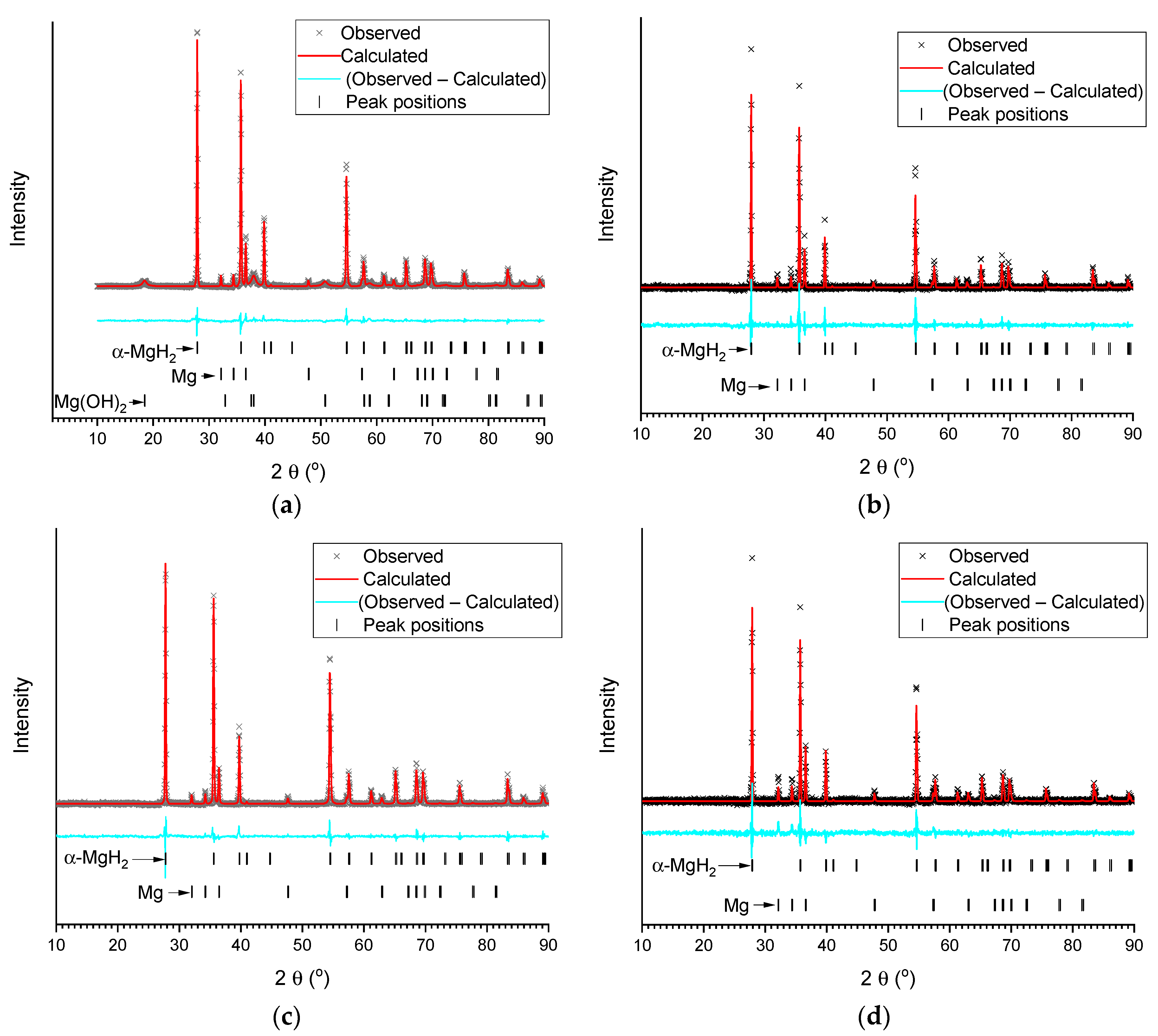

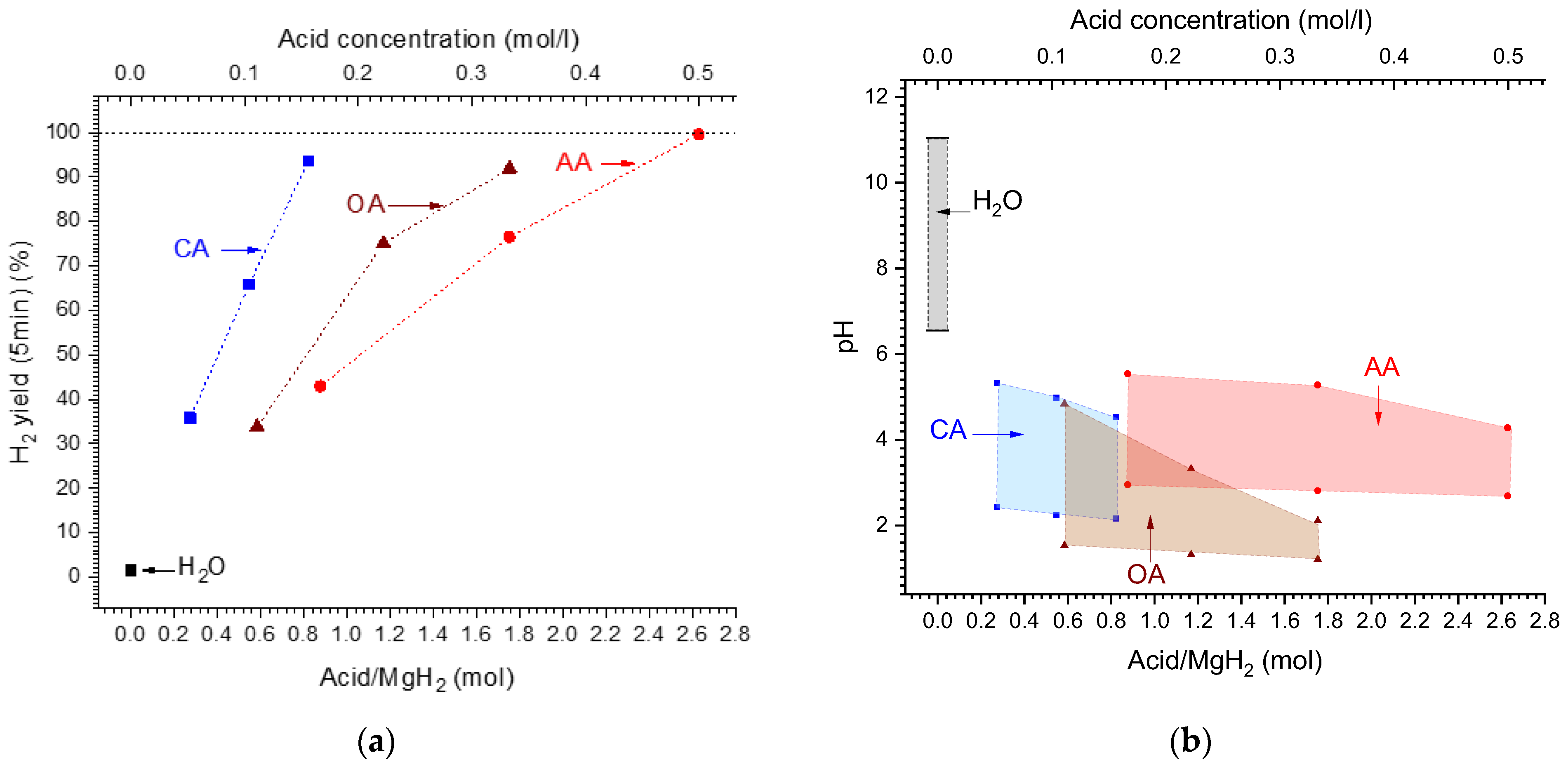
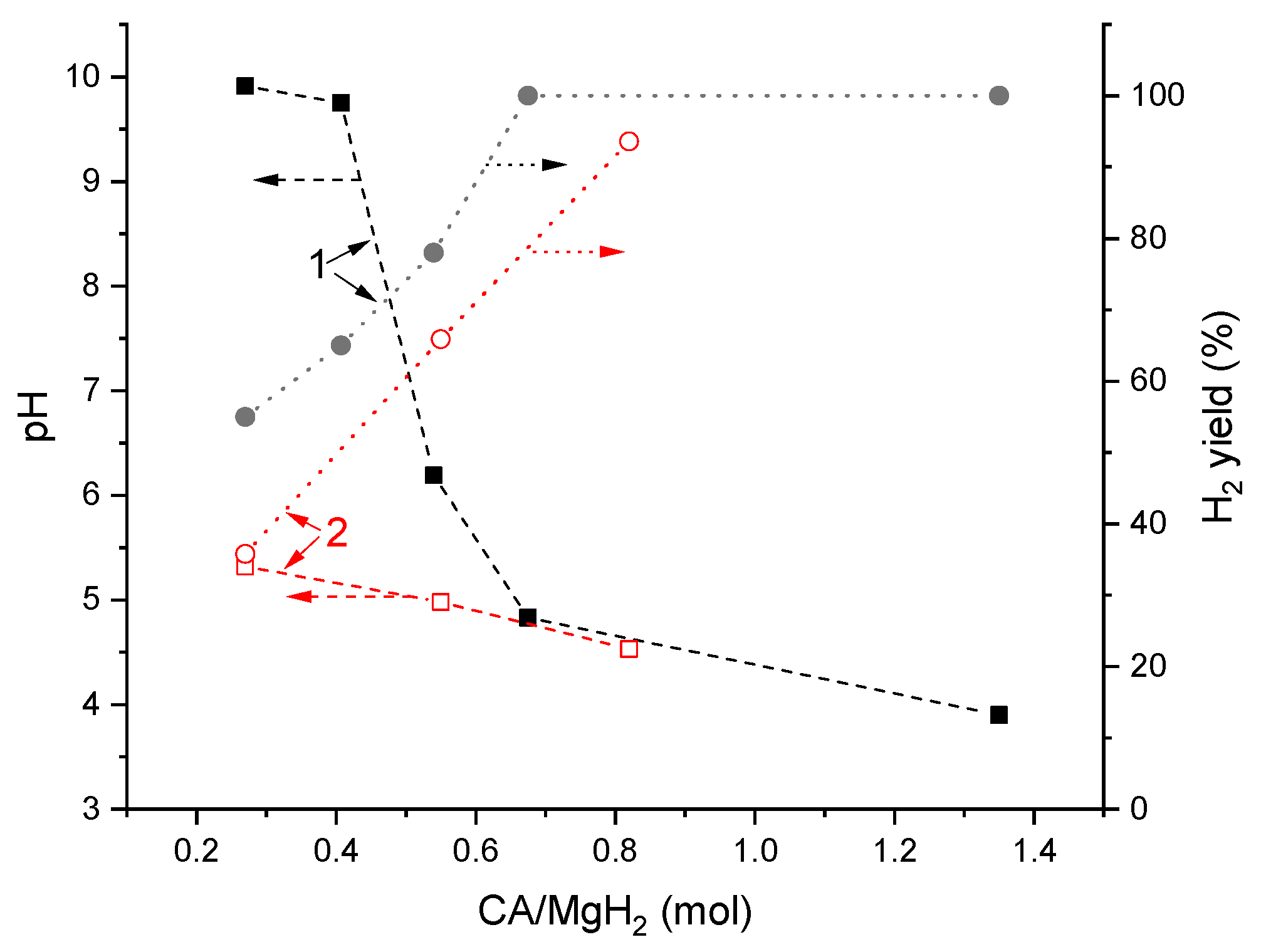

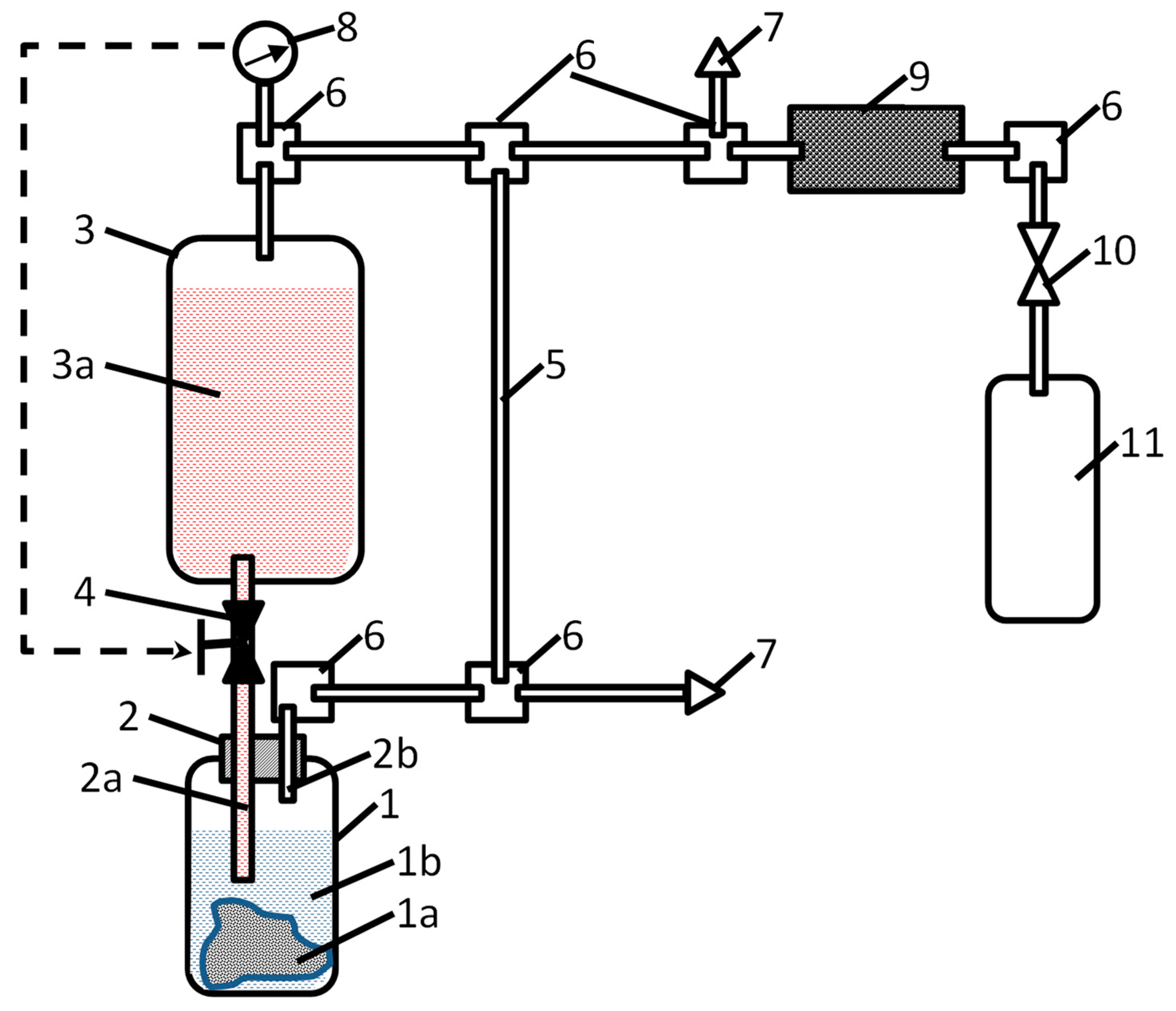
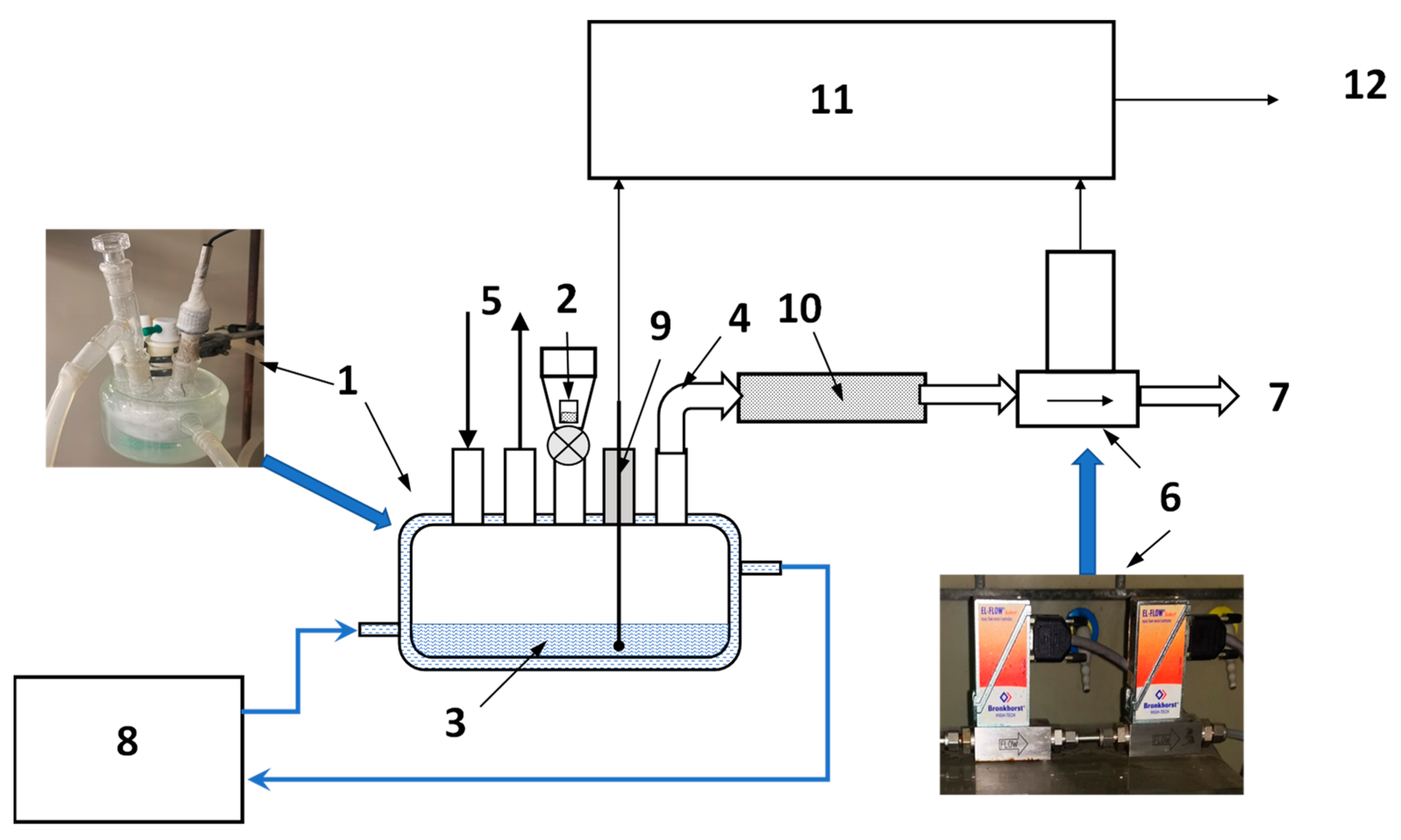
| Sample | Phase | Weight Abundance | Lattice Periods (Å) | Unit Cell Volume (Å3) | Estimated Crystallite Size (nm) | |
|---|---|---|---|---|---|---|
| a | c | |||||
| As-delivered commercial MgH2 | α-MgH2 | 0.909 (-) | 4.51838 (6) | 3.02222 (7) | 61.701 (2) | >1000 |
| Mg | 0.091 (2) | 3.2134 (2) | 5.2146 (7) | 46.633 (8) | 900 | |
| Deposit after hydrolysis of MgH2 in deionised water | α-MgH2 | 0.693 (-) | 4.51568 (5) | 3.02087 (6) | 61.600 (2) | >1000 |
| Mg | 0.090 (1) | 3.2105 (2) | 5.2101 (4) | 46.506 (5) | >1000 | |
| Mg(OH)2 | 0.217 (3) | 3.142 (1) | 4.787 (2) | 40.92 (2) | 11 | |
| Deposit after hydrolysis of MgH2 in acetic acid solution | α-MgH2 | 0.846 (-) | 4.51529 (7) | 3.02013 (8) | 61.574 (2) | >1000 |
| Mg | 0.154 (3) | 3.2104 (3) | 5.2116 (9) | 46.52 (1) | >1000 | |
| Deposit after hydrolysis of MgH2 in citric acid solution | α-MgH2 | 0.892 (-) | 4.51393 (6) | 3.01982 (7) | 61.530 (2) | >1000 |
| Mg | 0.108 (2) | 3.2101 (2) | 5.2114 (7) | 46.508 (6) | 800 | |
| Deposit after hydrolysis of MgH2 in oxalic acid solution | α-MgH2 | 0.818 (-) | 4.51494 (8) | 3.0197 (1) | 61.556 (2) | >1000 |
| Mg | 0.182 (3) | 3.2099 (2) | 5.2101 (7) | 46.492 (6) | >1000 | |
| Organic Acid | Brutto Formula | Molecular Weight (g/mol) | Dissociation Constants at T = 25 °C [50] | Solubility of Mg Salt in Water at T = 25 °C (g/L) [51] | Concentrations Used in the Experiments | |||
|---|---|---|---|---|---|---|---|---|
| K1 | K2 | K3 | (wt.%) | (g-mol/L) | ||||
| Acetic (AA) | C2O2H4 | 60.052 | 1.75 × 10−5 | – | – | 656 | 1.0 | 0.17 |
| 2.0 | 0.33 | |||||||
| 3.0 | 0.50 | |||||||
| Citric (CA) | C6O7H8 | 192.123 | 7.4 × 10−4 | 1.7 × 10−5 | 4.0 × 10−7 | 200 | 1.0 | 0.05 |
| 2.0 | 0.10 | |||||||
| 3.0 | 0.16 | |||||||
| Oxalic (OA) | C2O4H2 | 90.034 | 5.6 × 10−2 | 1.5 × 10−4 | – | 0.38 | 1.0 | 0.11 |
| 2.0 | 0.22 | |||||||
| 3.0 | 0.33 | |||||||
| Acid | Concentration | Acid/MgH2 Ratio | H2 Yield after 5 min from Reaction Start (%) | pH | |||
|---|---|---|---|---|---|---|---|
| (wt.%) | (mol/L) | Weight | Molar | Initial | Final | ||
| None (water) | 0.00 | 0.00 | 0.00 | 0.00 | 1.55 | 6.55 | 11.04 |
| Acetic (AA) | 1.00 | 0.17 | 2.00 | 0.88 | 42.92 | 2.95 | 5.54 |
| 2.00 | 0.33 | 4.00 | 1.75 | 76.47 | 2.81 | 5.28 | |
| 3.00 | 0.50 | 6.00 | 2.63 | 99.56 | 2.69 | 4.28 | |
| Citric (CA) | 1.00 | 0.05 | 2.00 | 0.27 | 35.76 | 2.43 | 5.32 |
| 2.00 | 0.10 | 4.00 | 0.55 | 65.87 | 2.25 | 4.98 | |
| 3.00 | 0.16 | 6.00 | 0.82 | 93.59 | 2.16 | 4.53 | |
| Oxalic (OA) | 1.00 | 0.11 | 2.00 | 0.58 | 33.79 | 1.53 | 4.84 |
| 2.00 | 0.22 | 4.00 | 1.17 | 75.09 | 1.32 | 3.32 | |
| 3.00 | 0.33 | 6.00 | 1.75 | 91.89 | 1.21 | 2.11 | |
| Organic Acid | Parameter (Units) | Value | ||
|---|---|---|---|---|
| T = 25 °C | T = 50 °C | T = 75 °C | ||
| Acetic (AA) | ti (min) | 0.411 ± 0.005 | 0.48 ± 0.01 | 0.40 ± 0.01 |
| t0 (min) | 6.9 ± 0.5 | 0.94 ± 0.03 | 0.83 ± 0.02 | |
| n (-) | 0.55 ± 0.02 | 0.62 ± 0.04 | 0.81 ± 0.03 | |
| EA (kJ/mol) | 37 ± 15 | |||
| Citric (CA) | ti (min) | 0.36 ± 0.02 | 0.46 ± 0.02 | 0.48 ± 0.01 |
| t0 (min) | 5.2 ± 0.3 | 2.2 ± 0.1 | 1.64 ± 0.07 | |
| n (-) | 0.79 ± 0.04 | 0.50 ± 0.04 | 0.50 ± 0.03 | |
| EA (kJ/mol) | 20 ± 4 | |||
| Oxalic (OA) | ti (min) | 0.40 ± 0.03 | 0.48 ± 0.01 | 0.46 ± 0.02 |
| t0 (min) | 3.8 ± 0.2 | 1.10 ± 0.04 | 0.69 ± 0.03 | |
| n (-) | 1.06 ± 0.05 | 0.61 ± 0.04 | 0.73 ± 0.05 | |
| EA (kJ/mol) | 30 ± 6 | |||
Disclaimer/Publisher’s Note: The statements, opinions and data contained in all publications are solely those of the individual author(s) and contributor(s) and not of MDPI and/or the editor(s). MDPI and/or the editor(s) disclaim responsibility for any injury to people or property resulting from any ideas, methods, instructions or products referred to in the content. |
© 2023 by the authors. Licensee MDPI, Basel, Switzerland. This article is an open access article distributed under the terms and conditions of the Creative Commons Attribution (CC BY) license (https://creativecommons.org/licenses/by/4.0/).
Share and Cite
Lototskyy, M.V.; Davids, M.W.; Sekgobela, T.K.; Arbuzov, A.A.; Mozhzhukhin, S.A.; Zhu, Y.; Tang, R.; Tarasov, B.P. Tailoring of Hydrogen Generation by Hydrolysis of Magnesium Hydride in Organic Acids Solutions and Development of Generator of the Pressurised H2 Based on this Process. Inorganics 2023, 11, 319. https://doi.org/10.3390/inorganics11080319
Lototskyy MV, Davids MW, Sekgobela TK, Arbuzov AA, Mozhzhukhin SA, Zhu Y, Tang R, Tarasov BP. Tailoring of Hydrogen Generation by Hydrolysis of Magnesium Hydride in Organic Acids Solutions and Development of Generator of the Pressurised H2 Based on this Process. Inorganics. 2023; 11(8):319. https://doi.org/10.3390/inorganics11080319
Chicago/Turabian StyleLototskyy, Mykhaylo V., Moegamat Wafeeq Davids, Tshepo Kgokane Sekgobela, Artem A. Arbuzov, Sergey A. Mozhzhukhin, Yongyang Zhu, Renheng Tang, and Boris P. Tarasov. 2023. "Tailoring of Hydrogen Generation by Hydrolysis of Magnesium Hydride in Organic Acids Solutions and Development of Generator of the Pressurised H2 Based on this Process" Inorganics 11, no. 8: 319. https://doi.org/10.3390/inorganics11080319
APA StyleLototskyy, M. V., Davids, M. W., Sekgobela, T. K., Arbuzov, A. A., Mozhzhukhin, S. A., Zhu, Y., Tang, R., & Tarasov, B. P. (2023). Tailoring of Hydrogen Generation by Hydrolysis of Magnesium Hydride in Organic Acids Solutions and Development of Generator of the Pressurised H2 Based on this Process. Inorganics, 11(8), 319. https://doi.org/10.3390/inorganics11080319







